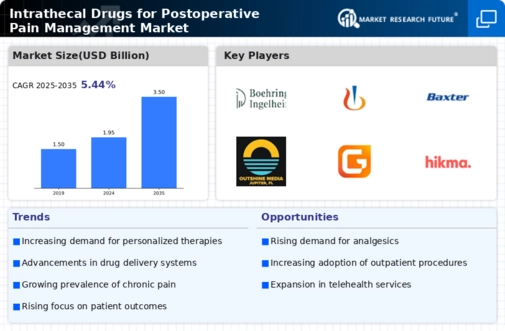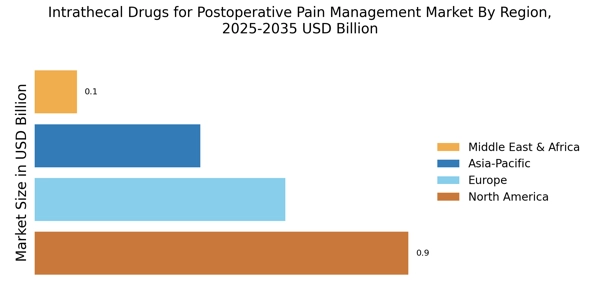Increase in Chronic Pain Conditions
The rising prevalence of chronic pain conditions is significantly impacting the Intrathecal Drugs for Postoperative Pain Management Market. As more individuals suffer from chronic pain, the demand for effective pain management solutions, including intrathecal drug delivery systems, is on the rise. Statistics indicate that nearly 20% of adults experience chronic pain, which often necessitates surgical interventions. This correlation suggests that as the population grapples with chronic pain, the market for intrathecal drugs will likely expand, driven by the need for effective postoperative pain management strategies. The ability of intrathecal drugs to provide targeted relief positions them as a preferred option for managing pain in this demographic.
Growing Awareness of Pain Management
There is a notable increase in awareness regarding the importance of effective pain management among healthcare providers and patients alike. This growing consciousness is significantly influencing the Intrathecal Drugs for Postoperative Pain Management Market. Educational initiatives and advocacy for pain management are leading to a shift in clinical practices, with more emphasis placed on utilizing advanced pain relief methods. Data indicates that approximately 80% of patients undergoing surgery experience moderate to severe pain postoperatively, underscoring the need for effective solutions. As healthcare professionals become more informed about the benefits of intrathecal drug delivery systems, the adoption of these therapies is expected to rise, further propelling market growth.
Rising Incidence of Surgical Procedures
The increasing number of surgical procedures performed worldwide is a primary driver for the Intrathecal Drugs for Postoperative Pain Management Market. As surgical techniques advance, more patients are opting for surgical interventions, leading to a heightened demand for effective pain management solutions. According to recent data, the volume of surgeries is projected to rise by approximately 5% annually, which directly correlates with the need for innovative pain management strategies. Intrathecal drugs, known for their targeted delivery and efficacy, are becoming increasingly favored in postoperative settings. This trend suggests that as surgical procedures become more commonplace, the market for intrathecal drugs will likely expand, driven by the necessity for improved postoperative pain control.
Technological Advancements in Drug Formulations
Technological innovations in drug formulations are playing a crucial role in shaping the Intrathecal Drugs for Postoperative Pain Management Market. Recent advancements have led to the development of more effective and safer intrathecal medications, enhancing their appeal among clinicians. For instance, the introduction of long-acting formulations allows for prolonged pain relief, reducing the frequency of administration. Market data suggests that the segment of long-acting intrathecal drugs is expected to witness a growth rate of over 6% in the coming years. These innovations not only improve patient outcomes but also encourage healthcare providers to adopt intrathecal therapies as a standard practice in postoperative pain management.
Regulatory Support for Pain Management Innovations
Regulatory bodies are increasingly recognizing the importance of effective pain management, which is fostering growth in the Intrathecal Drugs for Postoperative Pain Management Market. Recent initiatives aimed at streamlining the approval process for innovative pain management therapies are encouraging pharmaceutical companies to invest in research and development. This regulatory support is crucial, as it not only expedites the introduction of new intrathecal drugs but also enhances the overall market landscape. Data suggests that the approval timelines for new pain management drugs have decreased by approximately 15% in recent years, indicating a more favorable environment for innovation. As regulatory frameworks evolve, the market for intrathecal drugs is poised for expansion, driven by the introduction of novel therapies.


















Leave a Comment